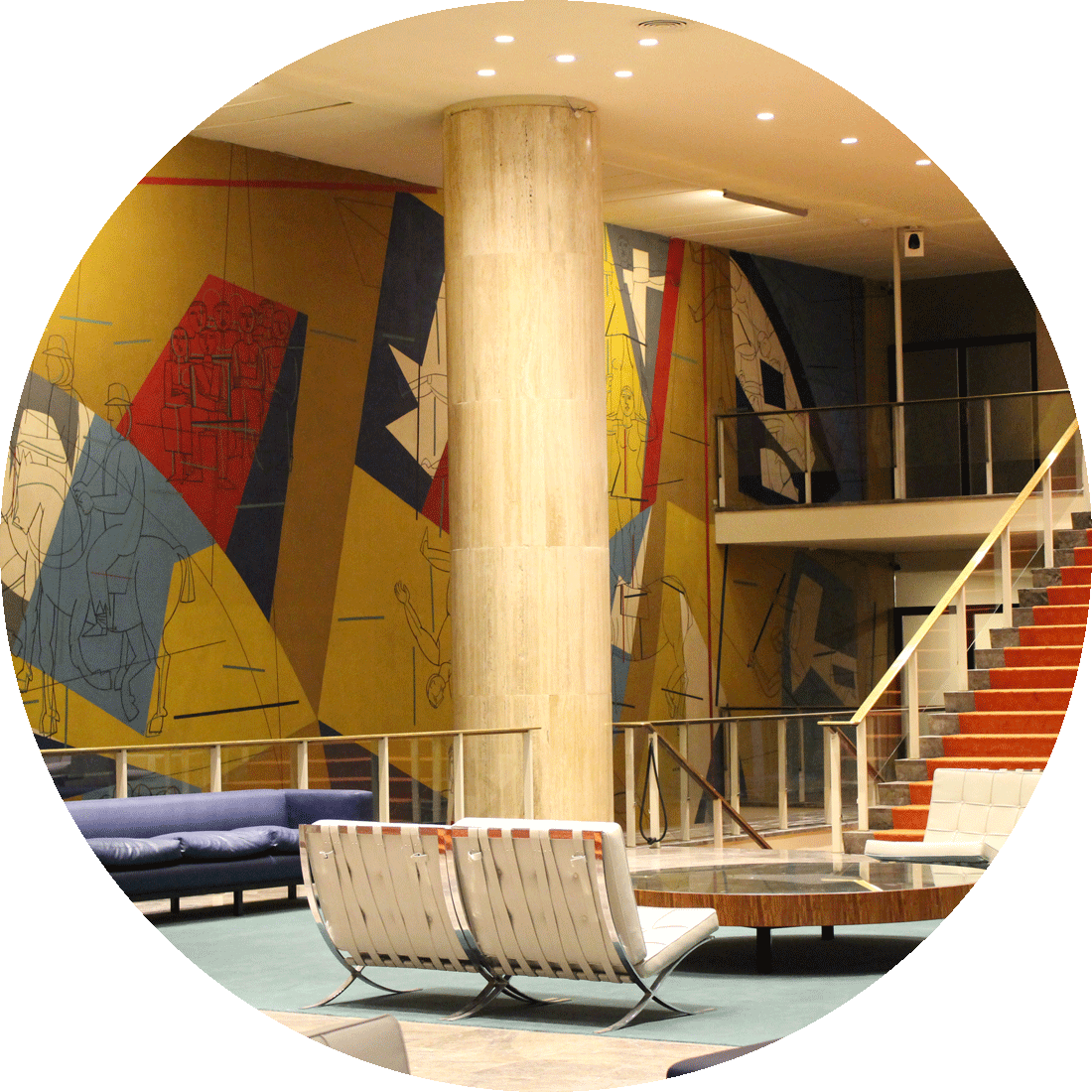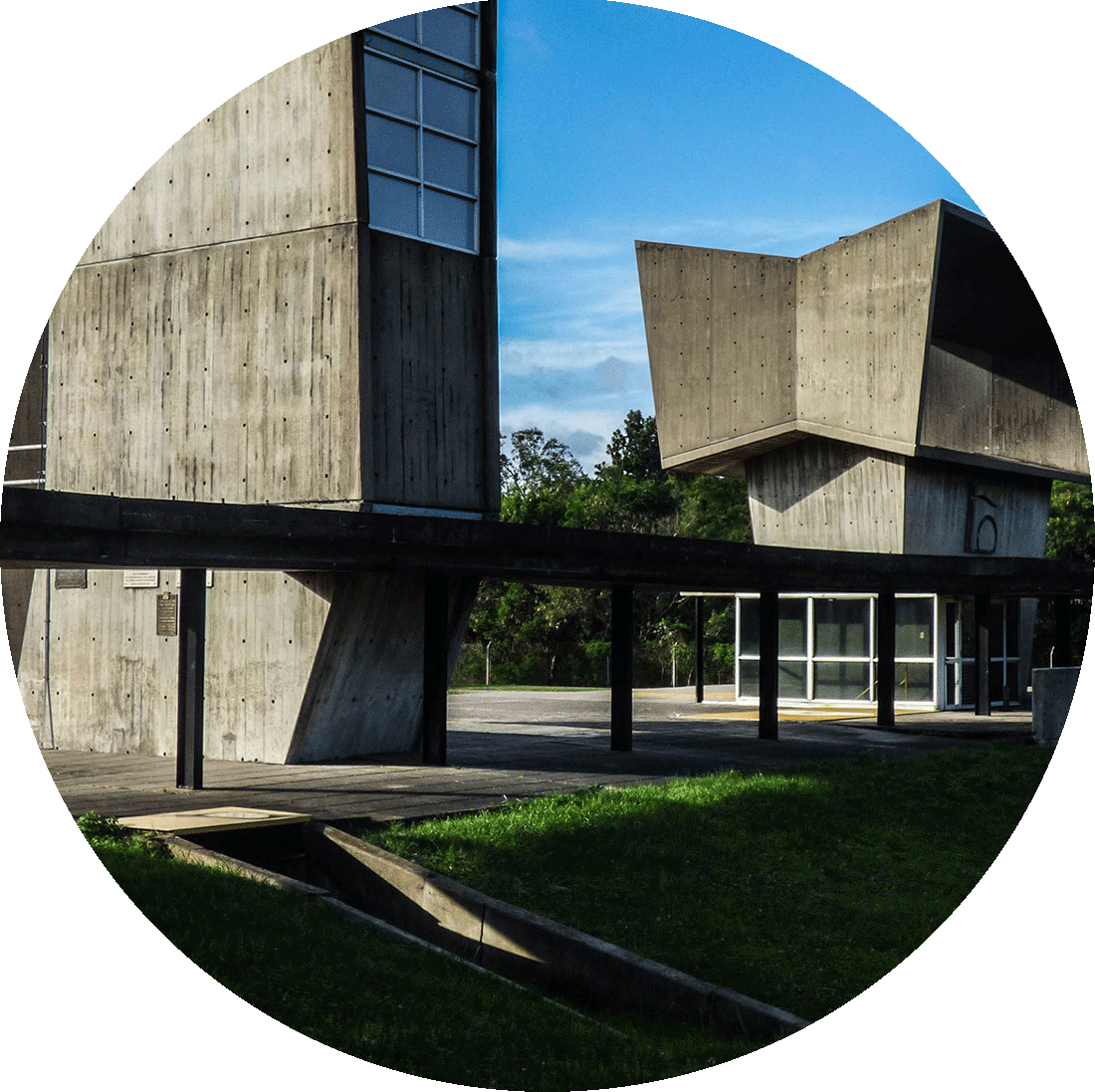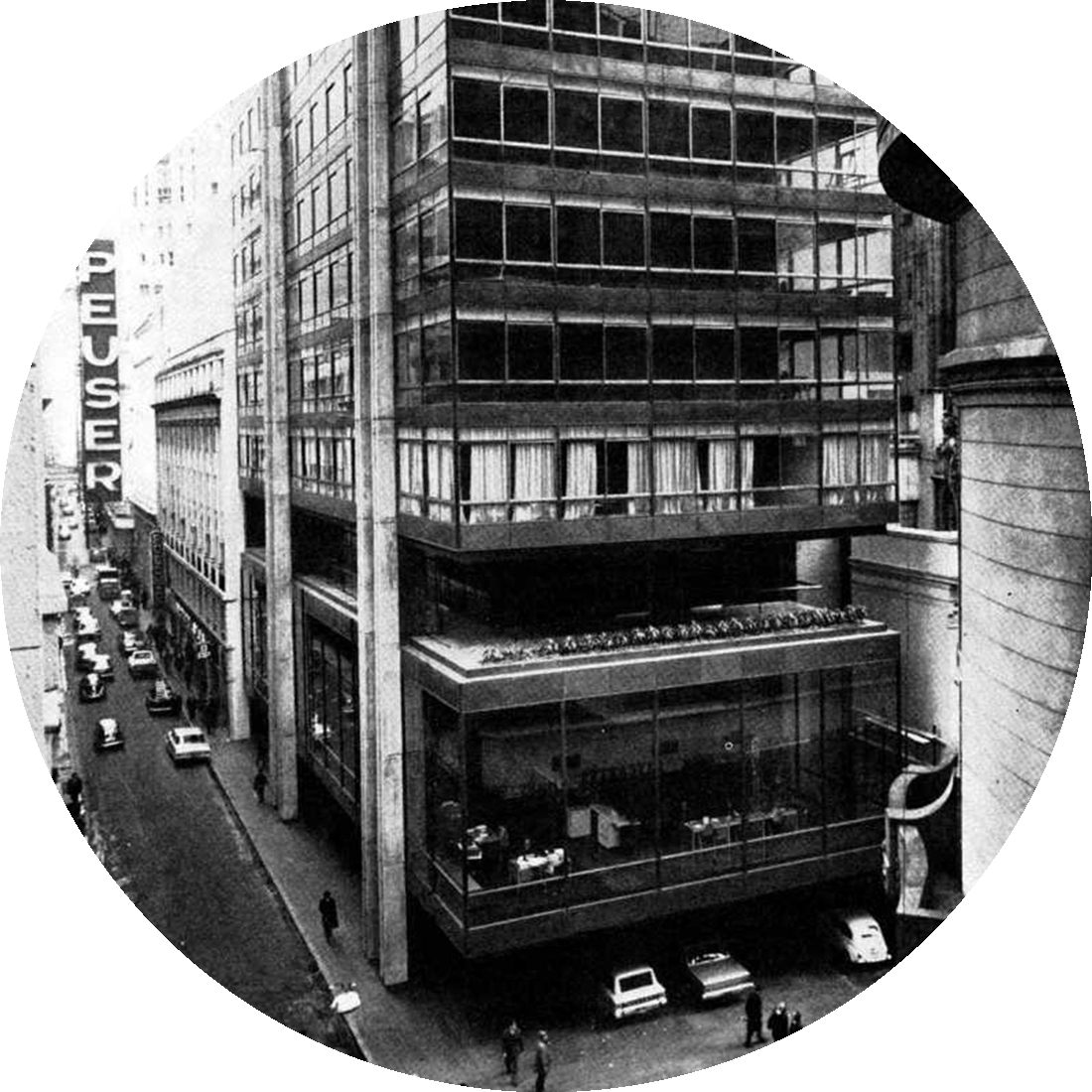“Architecture, as clearly as in medicine, must allow itself to evolve over time. Technological innovations in construction, based on new materials and obtaining flexible buildings, prepared for the future and adaptable to different changes of use, allow buildings to be durable over time."
Interview with Mario Roberto Álvarez, 2010.2
The persistence in Mario Roberto Álvarez's work is par excellence the curtain wall and the International Style, mainly because his architectural theme was largely associated with offices and housing. However, the architect did not hesitate to carry out other explorations outside of these programs, especially in contexts further away from the plots between party walls or strongly conditioned by their saturated environments, which were common in his work.
The work of Mario Roberto Álvarez in Argentina is, in short, synonymous with many things: corporate architecture, International Style, public works and intervention on buildings of historical value, and in this article we will try to condense part of that experience in seven of the most representative works of his career.
General San Martín Municipal Theatre (1953-1960) and General San Martín Cultural Center (1962-1970)

The General San Martín Municipal Theatre was not Álvarez's first work, who had begun his professional career nearly fifteen years earlier, but it was undoubtedly the one that opened the doors for him to enter the formerly select world of Argentine architecture and began to put him in the focus of modern discussion.
Born as part of a contest organized by the Municipality of Buenos Aires, with the help of the National Government, the work designed by Álvarez together with Macedonio Oscar Ruiz is located in the artistic heart of the capital, crossing the block completely from north to south, from the emblematic Corrientes street to Sarmiento.
The Theatre is part of a larger-scale cultural complex that includes the General San Martín Cultural Center, designed by the same architect and built just two years after the first one was completed.

Teatro Municipal General San Martín by Mario Roberto Álvarez and Macedonio Oscar Ruiz. Photograph by Gastongregorutti
Both works represent two of the most characteristic edges of the architect, with a façade facing Corrientes street (theatre) in a purely International Style, with a sober and refined plastic resolution of its façade, and a counter front of the building (cultural centre) with some hints of incipient brutalism in terms of morphology and treatment of materials (which would later become apparent in other projects) that responded to the centre's own programmatic demands, which required a more heterogeneous resolution.
But the interesting thing about the complex does not end there. Álvarez and Ruiz's typological approach proposed something rarely seen so far, the superposition of the two theatre rooms almost as if it were a horizontal property, a questioned gesture, yes, but absolutely disruptive and splendidly resolved in its details.
The theatre, resolved between party walls, is until today one of the most forceful examples of modern public work within the first Argentine Peronism, and it allows us to begin recognizing how the work of Mario Roberto Álvarez went far beyond a stylistic adherence to a certain form of European or North American architectural production, but rather it was a Modernity of its own, taking the resources of the reference architectures of the time and adapting them under its own rules to its new context.
Hernandarias Subfluvial Tunnel (1962-1969) and Salto Grande Dam (1962-1972)

Even without extending ourselves too much, and understanding the lesser relevance that these works have for Argentine canonical historiography, we believe it is important to dedicate at least one section to Álvarez's public work in the sixties and seventies.
Both works represent undertakings of a pure engineering nature in which the architect's intervention was limited to some specific areas. In the tunnel (today called the Raúl Uranga - Carlos Sylvestre Begnis Subfluvial Tunnel) that connects the cities of Paraná and Santa Fe, the intervention was restricted to the ventilation towers, access to the tunnel, toll booths and offices, while in the Salto Grande dam it included part of the dam, the section of the railway that passes over it and some booths located in that same space.
Both works represent two of the most characteristic edges of the architect, with a façade facing Corrientes street (theatre) in a purely International Style, with a sober and refined plastic resolution of its façade, and a counter front of the building (cultural centre) with some hints of incipient brutalism in terms of morphology and treatment of materials (which would later become apparent in other projects) that responded to the centre's own programmatic demands, which required a more heterogeneous resolution.
But the interesting thing about the complex does not end there. Álvarez and Ruiz's typological approach proposed something rarely seen so far, the superposition of the two theatre rooms almost as if it were a horizontal property, a questioned gesture, yes, but absolutely disruptive and splendidly resolved in its details.
The theatre, resolved between party walls, is until today one of the most forceful examples of modern public work within the first Argentine Peronism, and it allows us to begin recognizing how the work of Mario Roberto Álvarez went far beyond a stylistic adherence to a certain form of European or North American architectural production, but rather it was a Modernity of its own, taking the resources of the reference architectures of the time and adapting them under its own rules to its new context.
Hernandarias Subfluvial Tunnel (1962-1969) and Salto Grande Dam (1962-1972)

Even without extending ourselves too much, and understanding the lesser relevance that these works have for Argentine canonical historiography, we believe it is important to dedicate at least one section to Álvarez's public work in the sixties and seventies.
Both works represent undertakings of a pure engineering nature in which the architect's intervention was limited to some specific areas. In the tunnel (today called the Raúl Uranga - Carlos Sylvestre Begnis Subfluvial Tunnel) that connects the cities of Paraná and Santa Fe, the intervention was restricted to the ventilation towers, access to the tunnel, toll booths and offices, while in the Salto Grande dam it included part of the dam, the section of the railway that passes over it and some booths located in that same space.

Subfluvial Tunnel Hernandarias by Mario Roberto Álvarez. Photograph courtesy of Santa Fe Government
However, although the interventions may be somewhat "minor", the architect took advantage of the characteristics of the implantation and the freedoms that these ex novo buildings could offer and of the autonomy in relation to their surroundings, to perform some explorations that, in general, they tend to be strictly associated with a select group of architects such as Testa or SEPRA.
However, although the interventions may be somewhat "minor", the architect took advantage of the characteristics of the implantation and the freedoms that these ex novo buildings could offer and of the autonomy in relation to their surroundings, to perform some explorations that, in general, they tend to be strictly associated with a select group of architects such as Testa or SEPRA.
“The functional and mechanical condition of the facilities in the answers given by Álvarez acquires a specific and appropriate formal poetics, which is expressed materially with the forcefulness of reinforced concrete (…) used by architectural trends to which Reyner Banham and other authors agreed in categorize as "brutalism". However, Álvarez's work, (…) departs from this classification: in his work, the technique, the tectonic and the expressive come together in a studied coupling with the functional, the product of a long experience in the obsessive adjustment of the details."
Luis Müller and Camila Costa, 2017.3
In these works, beyond the link with the landscape that can be recognized (even more so in the dam), the architect made use of these freedoms to execute operations that are already far from those pure and silent forms of the facade of the Theater, in pursuit of new irregular geometries, with great strength and visual weight, and with explorations in the expressiveness of raw materials such as reinforced concrete, used throughout the whole work, or in industrialized materials that are not so common in his work such as the mosaics that line the facades of the tunnel offices.
Bank of America Building (1963-1965)

Located in the heart of downtown Buenos Aires, the Bank of America is a project developed by Mario Roberto Álvarez in conjunction with a renowned group of local architects such as José Aslan, Héctor Ezcurra, Alfredo Joselevich and Alberto Víctor Ricur.
The first of this series of buildings that has a completely corporate program is made up of a prismatic volume divided into two superimposed blocks, which as we can begin to see, will be a conceptual leitmotif throughout almost all of the architect's carreer.
Even breaking the Platonic shape of the volume, the building continues to incorporate the Miesian maxims to the whole, translated from the very intersubjectivity of the context. In addition to the curtain walls that run through the prism and give it that image to a certain extent silent, the work is structurally supported only from four large columns and a prism that leans on the two dividing walls that form the corner, thus allowing to release a large part of the ground floor and expand the sidewalk, but also allows a completely liberated type floor according to the functional premises of the International Style.
Teniente General Castiñeiras Building - SOMISA (1966-1977)

The building for the Sociedad Mixta Siderúrgica Argentina (SOMISA) is another of Álvarez's most iconic works, which denotes local permeability in relation to the adoption of external forms as modes of designing, and probably the greatest example of the most industrialized modernity of the Master.
The modernity of the work was already conditioned by the client, a growing state-owned steel company, which demanded the highest methodological rigour in the use of new materials and technologies. For this reason, the building was conceived as a technological and corporate symbol that took steel as its own expressive medium under the concept of “building-machine”.
The work is located in a triangular plot that acts as the second great conditioning factor of the project. This is solved by means of the urban completion from continuity in morphology and height of the block, distancing itself from its neighbours exclusively due to its technological resolution.
It is possible to clearly recognize how this first building, completely made of steel of national production (except for the seven basements that also incorporate reinforced concrete), is indebted to many of the Miesian concepts that were in vogue at that time. Curtain walls, running windows, materials, resolution of details, and even furniture are aspects inherited from the Master, which Álvarez knew how to incorporate into his production without abandoning the founding principles of his work.
IBM Building (1979-1983)

The last work in this series is again a building for corporate use, this time located in the city of Buenos Aires in the enclave made purely of corporate architecture placed between Puerto Madero and the Retiro neighbourhood, and it was precisely one of the first works to begin moulding the profile of this area with that business image that is today so identifying.
In relation to the city, the architect solves its implementation in a similar way as he did in the building for SOMISA. This firm idea of separating itself from its environment through different actions that make it unique, so characteristic of corporate architecture, is materialized in this case from the exposed concrete ribs that run through each level with recessed glazing throughout its development, and the detachment operations between the basement, the shaft and the main body of the tower.

IBM Building by Mario Roberto Álvarez. Photograph by Alex Proimos
The building basically consists of a tower perched on two large reinforced concrete central cores that rest on a base. But perhaps the most interesting element lies in the visible relationship between this work and the Bank of America. A relationship not only programmatic, or to a certain point morphological, but in the almost brutalist intentionality (in its most literal sense) of Mario Roberto Álvarez when performing that subtraction (or separation) of the volume, showing us, once again, how despite from the time jump between one work and another, or the different material and constructive resolutions, the architect's professional career never lost the foundations that conceptually established his architectural ideology.
Perhaps the work of Mario Roberto Álvarez does not have the grandiloquence of the Bank of London or the National Library of Clorindo Testa, but without a doubt, the dialogue between these two architectures has marked the last sixty or seventy years of the discipline in Argentina, with an Álvarez much more inclined towards silent proposals in his expression apropos of the city (although contrasting, of course), or with more measured stakes in his formal resolutions, but which were always marked by two vital aspects: the rigour of the Master's discipline and the coherence in all his architectural production, even in his most exploratory periods.
NOTES.-
The building basically consists of a tower perched on two large reinforced concrete central cores that rest on a base. But perhaps the most interesting element lies in the visible relationship between this work and the Bank of America. A relationship not only programmatic, or to a certain point morphological, but in the almost brutalist intentionality (in its most literal sense) of Mario Roberto Álvarez when performing that subtraction (or separation) of the volume, showing us, once again, how despite from the time jump between one work and another, or the different material and constructive resolutions, the architect's professional career never lost the foundations that conceptually established his architectural ideology.
Perhaps the work of Mario Roberto Álvarez does not have the grandiloquence of the Bank of London or the National Library of Clorindo Testa, but without a doubt, the dialogue between these two architectures has marked the last sixty or seventy years of the discipline in Argentina, with an Álvarez much more inclined towards silent proposals in his expression apropos of the city (although contrasting, of course), or with more measured stakes in his formal resolutions, but which were always marked by two vital aspects: the rigour of the Master's discipline and the coherence in all his architectural production, even in his most exploratory periods.
NOTES.-
1- In 2017, the Museum of Architecture and Design of the SCA organized an exhibition on the architecture of Testa and Álvarez entitled A "polo and Dionisos in Argentine Architecture - Mario Roberto Álvarez and Clorindo Testa together in the Marq".
2- Mario Roberto Álvarez: reflexiones de un maestro. Interview with Mario Roberto Álvarez for the radio program Vivienda en el aire. November 27, 2010. Retrieved from https://bit.ly/36QIBTs
3- Müller, Luis & Costa, Camila (2017) Vencer al río. Técnica, política e integración territorial en el caso del Túnel Subfluvial Hernandarias. XVI Jornadas Interescuelas/Departamentos de Historia. Departamento de Historia. Facultad Humanidades. Universidad Nacional de Mar del Plata. P. 13. Mar del Plata. Argentina.
2- Mario Roberto Álvarez: reflexiones de un maestro. Interview with Mario Roberto Álvarez for the radio program Vivienda en el aire. November 27, 2010. Retrieved from https://bit.ly/36QIBTs
3- Müller, Luis & Costa, Camila (2017) Vencer al río. Técnica, política e integración territorial en el caso del Túnel Subfluvial Hernandarias. XVI Jornadas Interescuelas/Departamentos de Historia. Departamento de Historia. Facultad Humanidades. Universidad Nacional de Mar del Plata. P. 13. Mar del Plata. Argentina.
BIBLIOGRAPHY.-
Fernandez, Roberto (1996) La ilusión proyectual: una historia de la arquitectura argentina. 1955-1995. Mar del Plata. Argentina: FADU, UNMDP.
Liernur, Jorge Francisco (2001) Arquitectura en la Argentina del siglo XX: la construcción de la modernidad. Buenos Aires. Argentina: Fondo Nacional de las Artes.
Montaner, Josep Maria (1999) Después del movimiento moderno: arquitectura de la segunda mitad del siglo XX. 4th. Edition. Barcelona. Spain: Gustavo Gili.
Montaner, Josep Maria (2002)Las formas del siglo XX. Barcelona. Spain: Gustavo Gili
Müller, Luis & Costa, Camila (2017) Vencer al río. Técnica, política e integración territorial en el caso del Túnel Subfluvial Hernandarias. XVI Jornadas Interescuelas/Departamentos de Historia. Departamento de Historia. Facultad Humanidades. Universidad Nacional de Mar del Plata. Mar del Plata. Argentina.
Mendez, Patricia S. (2016) Mario Roberto Álvarez. Modernidad disciplinada. En La arquitectura moderna en Latinoamérica: Antología de autores, obras y textos. Pp. 135-146. Madrid. Spain: Editorial Reverté.
Liernur, Jorge Francisco (2001) Arquitectura en la Argentina del siglo XX: la construcción de la modernidad. Buenos Aires. Argentina: Fondo Nacional de las Artes.
Montaner, Josep Maria (1999) Después del movimiento moderno: arquitectura de la segunda mitad del siglo XX. 4th. Edition. Barcelona. Spain: Gustavo Gili.
Montaner, Josep Maria (2002)Las formas del siglo XX. Barcelona. Spain: Gustavo Gili
Müller, Luis & Costa, Camila (2017) Vencer al río. Técnica, política e integración territorial en el caso del Túnel Subfluvial Hernandarias. XVI Jornadas Interescuelas/Departamentos de Historia. Departamento de Historia. Facultad Humanidades. Universidad Nacional de Mar del Plata. Mar del Plata. Argentina.
Mendez, Patricia S. (2016) Mario Roberto Álvarez. Modernidad disciplinada. En La arquitectura moderna en Latinoamérica: Antología de autores, obras y textos. Pp. 135-146. Madrid. Spain: Editorial Reverté.












































